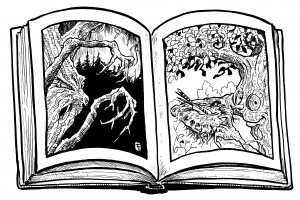From Scared to Sacred: Changing our Relationship to Nature through Story

Originally appears in the Fall 2009 issue
I remember lying on the carpet at home as a child, listening to some of the story recordings my mother would put on the phonograph. In Little Red Riding Hood, images of shadowy forests full of hungry wolves danced through my head as I awaited the “chime,” which signaled me to turn the page. In grade two, those same trees would creep through my thoughts as the teacher read Hansel and Gretel aloud to the class after recess. In grade eight, we read Gary Paulson’s The Hatchet, which details one boy’s struggle to survive against the fierce Canadian wild. In high school we learned the magic of the night forest in Shakespeare’s A Midsummer Night’s Dream and saw its destructive power over young minds in Golding’s Lord of the Flies. Thinking about these stories from my childhood, I began to wonder if the stories being told outside of home and school are any different.
I was at a movie theatre recently. During an extended wait in the ticket line, my eyes began to wander around the lobby taking in the massive Hollywood movie posters. One billboard in particular caught my eye. It was an advertisement for the latest horror movie, and depicted the silhouette of a woman peering into a window, overshadowed by a stormy sky, and, behind her, a forest. How interesting, I thought, that a wooded setting was chosen for this poster. The artist knew that in order to elicit a certain emotional response from the audience — fear — the perfect context would be a wooded lot in late autumn.
This sort of poster is not atypical, but as an environmental educator I find it disturbing. Consider, for instance, if it was your face the artist used peering through the window. Would you be offended that your image was used to frighten people? Similarly, would people react differently to you — even those who had never met you — simply because they saw your face on a movie advertisement? I wonder, then, how our view of the forest changes with each story. Could I walk though the forest on a cloudy day without getting the feeling that someone was watching me? Or could I sleep in the woods after watching The Blair Witch Project? Are my kids going to play outside with the same innocence after reading Little Red Riding Hood? The stories we tell, and the imagery within them, have a profound effect on how we experience the natural world.
This content is restricted to subscribers only.
If you are not yet a subscriber, please consider taking out a subscription here.
If you are an existing subscriber, kindly log in or contact us at info@greenteacher.com for more information.










